1.前提准备
环境介绍
-
haystack是django的开源搜索框架,该框架支持Solr, Elasticsearch, Whoosh, *Xapian*搜索引擎,不用更改代码,直接切换引擎,减少代码量。
-
搜索引擎使用Whoosh,这是一个由纯Python实现的全文搜索引擎,没有二进制文件等,比较小巧,配置比较简单,当然性能自然略低。whoosh和xapian的性能差距还是比较明显。索引和搜索的速度有近4倍的差距,在full cache情况下的性能差距更是达到了60倍。
-
中文分词+,由于Whoosh自带的是英文分词,对中文的分词支持不是太好,故用jieba替换whoosh的分词组件。
-
Elasticsearch:开源的搜索引擎,本文版本为7.6.0
-
其他:Python3.6.5, Django2.2
安装环境
pip3 install django==2.2 -i https://pypi.douban.com/simple
pip3 install whoosh -i https://pypi.douban.com/simple
pip3 install django-haystack -i https://pypi.douban.com/simple
pip3 install jieba -i https://pypi.douban.com/simple
pip3 install pymysql -i https://pypi.douban.com/simple
pip3 install elasticsearch==7.6.0 -i https://pypi.douban.com/simple/项目结构
- Project
- Project
- settings.py
- blog
- models.py表结构
models.py
from django.db import models
class UserInfo(models.Model):
username = models.CharField(verbose_name='用户名', max_length=225)
def __str__(self):
return self.username
class Tag(models.Model):
name = models.CharField(verbose_name='标签名称', max_length=225)
def __str__(self):
return self.name
class Article(models.Model):
title = models.CharField(verbose_name='标题', max_length=225)
content = models.CharField(verbose_name='内容', max_length=225)
# 外键
username = models.ForeignKey(verbose_name='用户', to='UserInfo', on_delete=models.DO_NOTHING)
tag = models.ForeignKey(verbose_name='标签', to='Tag', on_delete=models.DO_NOTHING)
def __str__(self):
return self.title
图解
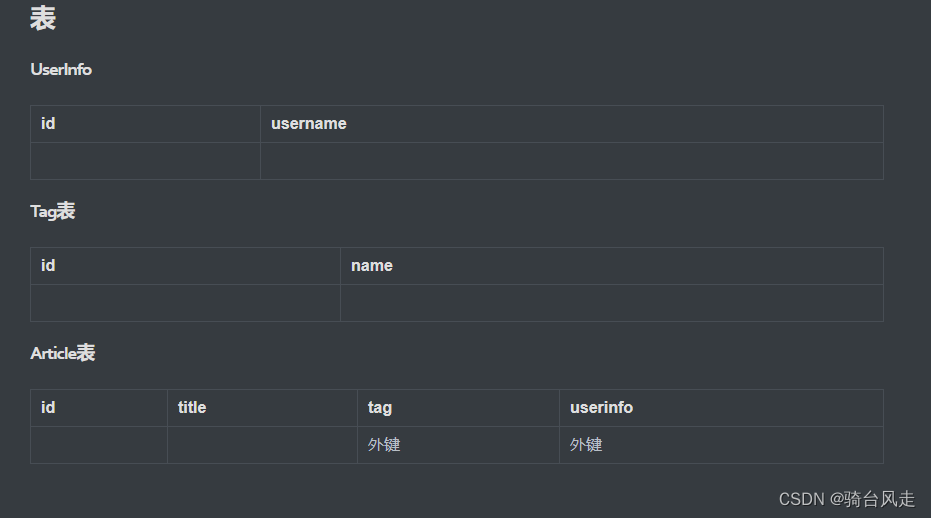
本文优势
集全网的django+django-haystack+Whoosh的总结,取其精华,去其糟粕,加入了新的注解。
如果你想你的es或者Whoosh集成到django上,那你来对地方了
django+django-haystack+Whoosh+Jieba+mysql
1. setting.py配置
# 数据库配置
DATABASES = {
'default': {
'ENGINE': 'django.db.backends.mysql',
'NAME': 'dj_ha',
'USER': 'root',
'PASSWORD': 'foobared',
'HOST': '106.14.42.253',
'PORT': '11111',
}
}
# app
INSTALLED_APPS = [
'haystack',
]
# 本教程使用的是Whoosh,故配置如下
HAYSTACK_CONNECTIONS = {
'default': {
'ENGINE': 'haystack.backends.whoosh_backend.WhooshEngine',
'PATH': os.path.join(os.path.dirname(__file__), 'whoosh_index'),
},
}
# 自动更新索引
HAYSTACK_SIGNAL_PROCESSOR = 'haystack.signals.RealtimeSignalProcessor'
# 设置每页显示的数目,默认为20,可以自己修改
HAYSTACK_SEARCH_RESULTS_PER_PAGE = 8
2. 为表模型创建索引,search_indexes.py
1. 如果你想针对某个app,例如blog做全文检索,则必须在blog的目录下面,建立search_indexes.py文件,文件名不能修改,必须叫search_indexes.py
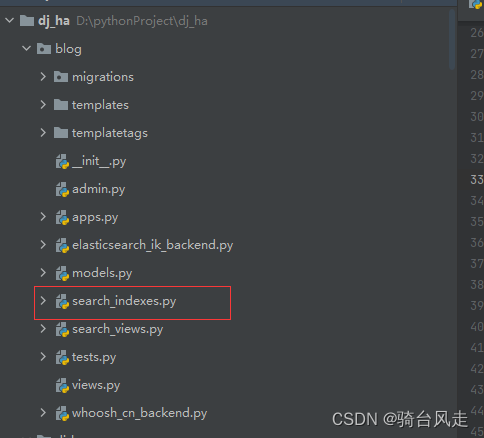
from haystack import indexes
from .models import Article
# ArticleIndex:固定写法 表名Index
class ArticleIndex(indexes.SearchIndex, indexes.Indexable):
# 固定写法 document=True:haystack和搜索引擎,将给text字段分词,建立索引,使用此字段的内容作为索引进行检索
# use_template=True,使用自己的模板,与document=True进行搭配,自定义检索字段模板(允许谁可以被全文检索,就是谁被建立索引)
text = indexes.CharField(document=True, use_template=True)
# 以下字段作为辅助数据,便于调用,最后也不知道怎么辅助,我注释了,也不影响搜索
# title:写入引擎的字段名,model_attr='title':相对应的表模型字段名,
title = indexes.CharField(model_attr='title')
content = indexes.CharField(model_attr='content')
username = indexes.CharField(model_attr='username')
tag = indexes.CharField(model_attr='tag')
def get_model(self):
# 需要建立索引的模型
return Article
def index_queryset(self, using=None):
"""Used when the entire index for model is updated."""
# 写入引擎的数据,必须返回queryset类型
return self.get_model().objects.all()
3. 创建被检索的模板(允许谁可以全文检索)
这个数据模板的作用是对Article.title, Article.content,Article.username.username
这三个字段建立索引,当检索的时候会对这三个字段的内容,做全文检索匹配。
数据模板的路径为yourapp/templates/search/indexes/yourapp/note_text.txt,
例如本例子为blog/templates/search/indexes/blog/article_text.txt 文件名必须为要索引的小写模型类名_text.txt
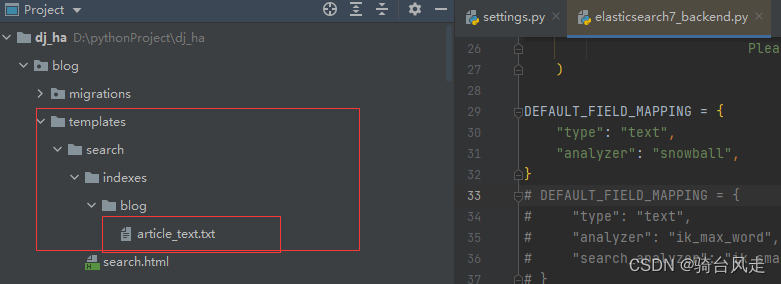
{{ object.title }}
{{ object.content }}
{{ object.username.username }}4. 路由
urls.py配置(用内置的视图,后期可以自定义,本文也有介绍)
# urls.py
from django.contrib import admin
from django.urls import path, include, re_path
urlpatterns = [
path('admin/', admin.site.urls),
# 配置的搜索路由,路由可以自定义,include('haystack.urls')固定
re_path(r'^search/', include('haystack.urls')),
]haystack.urls的内容(内置的,只是我拉出来,让你看一下,不需要进行修改)
from django.urls import path
from haystack.views import SearchView
urlpatterns = [path("", SearchView(), name="haystack_search")]5. search.html
SearchView()视图函数默认使用的html模板为当前app目录下,
路径为app名称,/templates/search/search.html
所以需要在blog/templates/search/下添加search.html文件,内容为
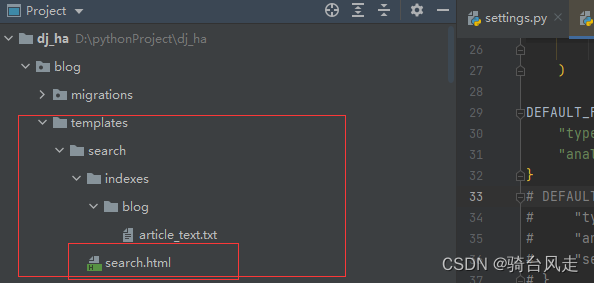
search.html(原生)
<h2>Search</h2>
<style>
span.highlighted {
color: red;
}
</style>
<!--高亮加载-->
{% load highlight %}
<form method="get" action=".">
<table>
<!-- 对象.as_table 生成表格,里边会自动成成input标签 -->
{{ form.as_table }}
{# {{ form.title.label }}#}
<tr>
<td></td>
<td>
<input type="submit" value="Search">
</td>
</tr>
</table>
{% if query %}
<h3>返回结果</h3>
{% for result in page.object_list %}
<!-- page.object_list:返回查询的一页数据 -->
<!-- result:数据对象 -->
<p>
{# <a href="{{ result.object.get_absolute_url }}">{{ result.object.title }}</a>#}
<a href="{{ result.object.get_absolute_url }}">{% highlight result.object.title with query %}</a>
</p>
<span>
{% highlight result.object.content with query %}
{# {{ result.object.content }}#}
</span>
{% empty %}
<p>没有查询到结果!!!</p>
{% endfor %}
<!-- 分页 -->
{% if page.has_previous or page.has_next %}
<div>
{% if page.has_previous %}<a href="?q={{ query }}&page={{ page.previous_page_number }}">{% endif %}«
Previous{% if page.has_previous %}</a>{% endif %}
|
{% if page.has_next %}<a href="?q={{ query }}&page={{ page.next_page_number }}">{% endif %}Next »
{% if page.has_next %}</a>{% endif %}
</div>
{% endif %}
{% else %}
{# Show some example queries to run, maybe query syntax, something else? #}
{% endif %}
</form>后端返回数据介绍
# print(context)
"""
{
'query': '刘',
'form': <ModelSearchForm bound=True, valid=True, fields=(q;models)>,
'page': <Page 1 of 1>,
'paginator': <django.core.paginator.Paginator object at 0x0000017D7E0F3470>,
'suggestion': None}
"""
# print(context.get('page').__dict__)
"""
{
'object_list':
[
<SearchResult: blog.article (pk=6)>,
<SearchResult: blog.article (pk=8)>,
<SearchResult: blog.article (pk=1)>
],
'number': 1,
'paginator': <django.core.paginator.Paginator object at 0x00000257C11A65C0>
}
"""前端返回数据介绍
{% load highlight %}:高亮加载 内置的会省略搜到的内容,之前的内容
{% load my_filters_and_tags %}:自定义高亮
form.as_table:生成表格,里边会自动成成input标签
query:查询的参数
page.object_list:返回的查询一页数据
result:数据对象集
result.object:当前查询的数据对象
page.has_previous or page.has_next:分页6. 高亮配置
# 7.高亮加载
<style>
span.highlighted {
color: red;
}
</style>
# 1.使用默认值
{% highlight result.summary with query %}
# 案例
<a href="{{ result.object.get_absolute_url }}">
{% highlight result.object.title with query %}
</a>
# 2.这里我们为 {{ result.summary }}里所有的 {{ query }} 指定了一个<div></div>标签,并且将class设置为highlight_me_please,这样就可以自己通过CSS为{{ query }}添加高亮效果了,怎么样,是不是很科学呢
{% highlight result.summary with query html_tag "div" css_class "highlight_me_please" %}
# 3.这里可以限制最终{{ result.summary }}被高亮处理后的长度
{% highlight result.summary with query max_length 40 %}
# 5.自定义使用(后面会介绍)
# 5.4格式
{% myhighlight <text_block> with <query> [css_class "class_name"] [html_tag "span"] [max_length 200] [start_head True] %}
# 5.2使用一
{% myhighlight result.object.content with query css_class "highlighted" html_tag "span" max_length 200 start_head True %}
# 5.3自定义二
{% myhighlight result.object.content with query css_class "highlighted" start_head True %} 7.自定义
自定义返回内容
在app下新建一个文件名称search_views
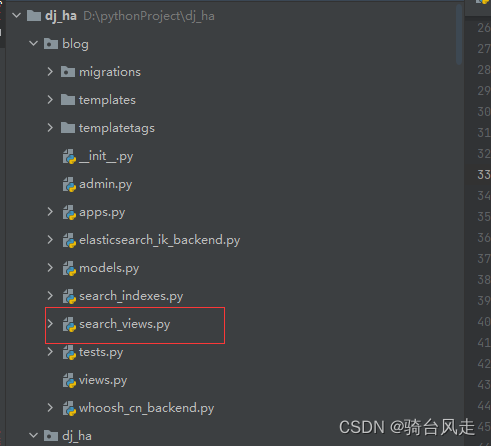
# 重写SearchView,实现自定义内容
# blog/search_views.py
from haystack.views import SearchView
# 导入模块
from .models import *
class MySeachView(SearchView):
def extra_context(self): # 重载extra_context来添加额外的context内容
context = super(MySeachView, self).extra_context()
my_str = '111'
context['my_str'] = my_str
# print(context)
return context
修改路由
from django.contrib import admin
from django.urls import path, include, re_path
from blog import search_views
urlpatterns = [
path('admin/', admin.site.urls),
# 原生的
# re_path(r'^search/', include('haystack.urls')),
# 自己的
re_path(r'^search/', search_views.MySeachView(), name='haystack_search'),
]前端使用
<div>
圆明园:{{ my_str }}
</div>自定义search.html模板
1. 保证有一个from,get请求,input标签的name=q,value=Search,
<form method="get" action=".">
<table>
<tr>
<th>
<label for="id_q">Search:</label>
</th>
<td>
<input type="search" name="q" value="不得不说" id="id_q">
</td>
</tr>
<tr>
<td>
<input type="submit" value="Search">
</td>
</tr>
</table>
</form>自定义高亮显示(原生的会省略)
新建文件夹templatetags
添加blog/templatetags/my_filters_and_tags.py 文件和 blog/templatetags/highlighting.py 文件,
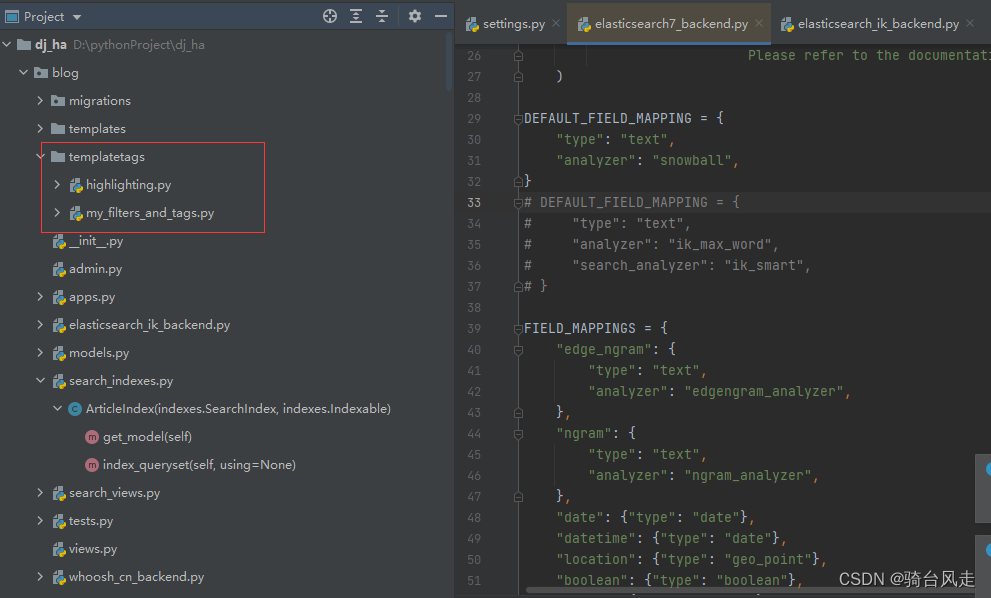
内容如下(源码分别位于haystack/templatetags/lighlight.py 和 haystack/utils/lighlighting.py 中):
my_filters_and_tags.py
# encoding: utf-8
from __future__ import absolute_import, division, print_function, unicode_literals
from django import template
from django.conf import settings
from django.core.exceptions import ImproperlyConfigured
from django.utils import six
from haystack.utils import importlib
register = template.Library()
class HighlightNode(template.Node):
def __init__(self, text_block, query, html_tag=None, css_class=None, max_length=None, start_head=None):
self.text_block = template.Variable(text_block)
self.query = template.Variable(query)
self.html_tag = html_tag
self.css_class = css_class
self.max_length = max_length
self.start_head = start_head
if html_tag is not None:
self.html_tag = template.Variable(html_tag)
if css_class is not None:
self.css_class = template.Variable(css_class)
if max_length is not None:
self.max_length = template.Variable(max_length)
if start_head is not None:
self.start_head = template.Variable(start_head)
def render(self, context):
text_block = self.text_block.resolve(context)
query = self.query.resolve(context)
kwargs = {}
if self.html_tag is not None:
kwargs['html_tag'] = self.html_tag.resolve(context)
if self.css_class is not None:
kwargs['css_class'] = self.css_class.resolve(context)
if self.max_length is not None:
kwargs['max_length'] = self.max_length.resolve(context)
if self.start_head is not None:
kwargs['start_head'] = self.start_head.resolve(context)
# Handle a user-defined highlighting function.
if hasattr(settings, 'HAYSTACK_CUSTOM_HIGHLIGHTER') and settings.HAYSTACK_CUSTOM_HIGHLIGHTER:
# Do the import dance.
try:
path_bits = settings.HAYSTACK_CUSTOM_HIGHLIGHTER.split('.')
highlighter_path, highlighter_classname = '.'.join(path_bits[:-1]), path_bits[-1]
highlighter_module = importlib.import_module(highlighter_path)
highlighter_class = getattr(highlighter_module, highlighter_classname)
except (ImportError, AttributeError) as e:
raise ImproperlyConfigured("The highlighter '%s' could not be imported: %s" % (settings.HAYSTACK_CUSTOM_HIGHLIGHTER, e))
else:
from .highlighting import Highlighter
highlighter_class = Highlighter
highlighter = highlighter_class(query, **kwargs)
highlighted_text = highlighter.highlight(text_block)
return highlighted_text
@register.tag
def myhighlight(parser, token):
"""
Takes a block of text and highlights words from a provided query within that
block of text. Optionally accepts arguments to provide the HTML tag to wrap
highlighted word in, a CSS class to use with the tag and a maximum length of
the blurb in characters.
Syntax::
{% highlight <text_block> with <query> [css_class "class_name"] [html_tag "span"] [max_length 200] %}
Example::
# Highlight summary with default behavior.
{% highlight result.summary with request.query %}
# Highlight summary but wrap highlighted words with a div and the
# following CSS class.
{% highlight result.summary with request.query html_tag "div" css_class "highlight_me_please" %}
# Highlight summary but only show 40 characters.
{% highlight result.summary with request.query max_length 40 %}
"""
bits = token.split_contents()
tag_name = bits[0]
if not len(bits) % 2 == 0:
raise template.TemplateSyntaxError(u"'%s' tag requires valid pairings arguments." % tag_name)
text_block = bits[1]
if len(bits) < 4:
raise template.TemplateSyntaxError(u"'%s' tag requires an object and a query provided by 'with'." % tag_name)
if bits[2] != 'with':
raise template.TemplateSyntaxError(u"'%s' tag's second argument should be 'with'." % tag_name)
query = bits[3]
arg_bits = iter(bits[4:])
kwargs = {}
for bit in arg_bits:
if bit == 'css_class':
kwargs['css_class'] = six.next(arg_bits)
if bit == 'html_tag':
kwargs['html_tag'] = six.next(arg_bits)
if bit == 'max_length':
kwargs['max_length'] = six.next(arg_bits)
if bit == 'start_head':
kwargs['start_head'] = six.next(arg_bits)
return HighlightNode(text_block, query, **kwargs)highlighting.py
# encoding: utf-8
from __future__ import absolute_import, division, print_function, unicode_literals
from django.utils.html import strip_tags
class Highlighter(object):
#默认值
css_class = 'highlighted'
html_tag = 'span'
max_length = 200
start_head = False
text_block = ''
def __init__(self, query, **kwargs):
self.query = query
if 'max_length' in kwargs:
self.max_length = int(kwargs['max_length'])
if 'html_tag' in kwargs:
self.html_tag = kwargs['html_tag']
if 'css_class' in kwargs:
self.css_class = kwargs['css_class']
if 'start_head' in kwargs:
self.start_head = kwargs['start_head']
self.query_words = set([word.lower() for word in self.query.split() if not word.startswith('-')])
def highlight(self, text_block):
self.text_block = strip_tags(text_block)
highlight_locations = self.find_highlightable_words()
start_offset, end_offset = self.find_window(highlight_locations)
return self.render_html(highlight_locations, start_offset, end_offset)
def find_highlightable_words(self):
# Use a set so we only do this once per unique word.
word_positions = {}
# Pre-compute the length.
end_offset = len(self.text_block)
lower_text_block = self.text_block.lower()
for word in self.query_words:
if not word in word_positions:
word_positions[word] = []
start_offset = 0
while start_offset < end_offset:
next_offset = lower_text_block.find(word, start_offset, end_offset)
# If we get a -1 out of find, it wasn't found. Bomb out and
# start the next word.
if next_offset == -1:
break
word_positions[word].append(next_offset)
start_offset = next_offset + len(word)
return word_positions
def find_window(self, highlight_locations):
best_start = 0
best_end = self.max_length
# First, make sure we have words.
if not len(highlight_locations):
return (best_start, best_end)
words_found = []
# Next, make sure we found any words at all.
for word, offset_list in highlight_locations.items():
if len(offset_list):
# Add all of the locations to the list.
words_found.extend(offset_list)
if not len(words_found):
return (best_start, best_end)
if len(words_found) == 1:
return (words_found[0], words_found[0] + self.max_length)
# Sort the list so it's in ascending order.
words_found = sorted(words_found)
# We now have a denormalized list of all positions were a word was
# found. We'll iterate through and find the densest window we can by
# counting the number of found offsets (-1 to fit in the window).
highest_density = 0
if words_found[:-1][0] > self.max_length:
best_start = words_found[:-1][0]
best_end = best_start + self.max_length
for count, start in enumerate(words_found[:-1]):
current_density = 1
for end in words_found[count + 1:]:
if end - start < self.max_length:
current_density += 1
else:
current_density = 0
# Only replace if we have a bigger (not equal density) so we
# give deference to windows earlier in the document.
if current_density > highest_density:
best_start = start
best_end = start + self.max_length
highest_density = current_density
return (best_start, best_end)
def render_html(self, highlight_locations=None, start_offset=None, end_offset=None):
# Start by chopping the block down to the proper window.
#text_block为内容,start_offset,end_offset分别为第一个匹配query开始和按长度截断位置
text = self.text_block[start_offset:end_offset]
# Invert highlight_locations to a location -> term list
term_list = []
for term, locations in highlight_locations.items():
term_list += [(loc - start_offset, term) for loc in locations]
loc_to_term = sorted(term_list)
# Prepare the highlight template
if self.css_class:
hl_start = '<%s class="%s">' % (self.html_tag, self.css_class)
else:
hl_start = '<%s>' % (self.html_tag)
hl_end = '</%s>' % self.html_tag
# Copy the part from the start of the string to the first match,
# and there replace the match with a highlighted version.
#matched_so_far最终求得为text中最后一个匹配query的结尾
highlighted_chunk = ""
matched_so_far = 0
prev = 0
prev_str = ""
for cur, cur_str in loc_to_term:
# This can be in a different case than cur_str
actual_term = text[cur:cur + len(cur_str)]
# Handle incorrect highlight_locations by first checking for the term
if actual_term.lower() == cur_str:
if cur < prev + len(prev_str):
continue
#分别添上每个query+其后面的一部分(下一个query的前一个位置)
highlighted_chunk += text[prev + len(prev_str):cur] + hl_start + actual_term + hl_end
prev = cur
prev_str = cur_str
# Keep track of how far we've copied so far, for the last step
matched_so_far = cur + len(actual_term)
# Don't forget the chunk after the last term
#加上最后一个匹配的query后面的部分
highlighted_chunk += text[matched_so_far:]
#如果不要开头not start_head才加点
if start_offset > 0 and not self.start_head:
highlighted_chunk = '...%s' % highlighted_chunk
if end_offset < len(self.text_block):
highlighted_chunk = '%s...' % highlighted_chunk
#可见到目前为止还不包含start_offset前面的,即第一个匹配的前面的部分(text_block[:start_offset]),如需展示(当start_head为True时)便加上
if self.start_head:
highlighted_chunk = self.text_block[:start_offset] + highlighted_chunk
return highlighted_chunk前端使用
<style>
span.highlighted {
color: red;
}
</style>
{% load my_filters_and_tags %}
{% myhighlight result.object.content with query css_class "highlighted" html_tag "span" max_length 200 start_head True %}
8. 目前位置搜索已经完成,可以重建索引,同步数据,测试一下
python manage.py rebuild_index
9.jieba分词器配置
9.1 先从python包中复制whoosh_backend.py到app中,并改名为whoosh_cn_backend.py
文件路径:\site-packages\haystack\backends\whoosh_backend.py
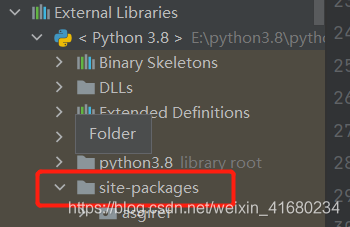
复制到的路径:
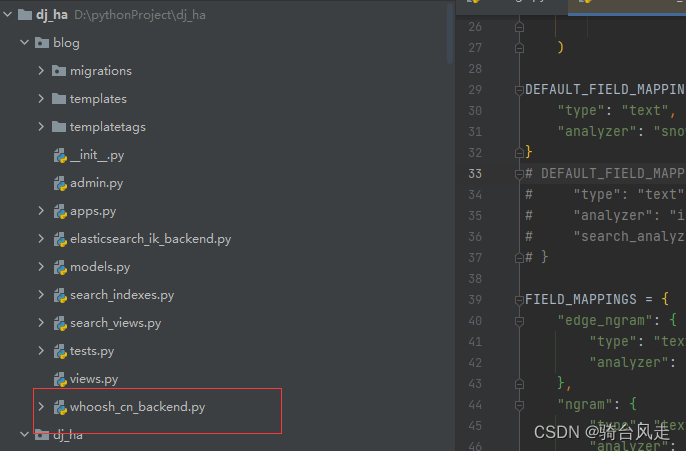
9.2 对whoosh_cn_backend.py做以下修改:
1、导入 ChineseAnalyze
from jieba.analyse import ChineseAnalyzer
2、替换schema_fields[field_class.index_fieldname] = TEXT(下的analyzer
analyzer=ChineseAnalyzer(),
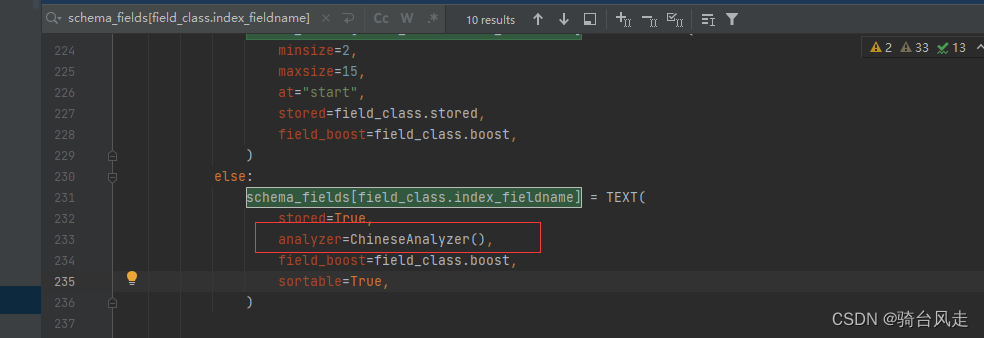
9.3 在django的配置文件中,修改搜索引擎
HAYSTACK_CONNECTIONS = {
'default': {
# 设置haystack的搜索引擎
'ENGINE': 'blog.whoosh_cn_backend.WhooshEngine',
# 'ENGINE': 'haystack.backends.whoosh_backend.WhooshEngine',
# 设置索引文件的位置
'PATH': os.path.join(BASE_DIR, 'whoosh_index'),
}
}10 django+django-haystack+Elasticsearch7.5+ik+mysql
10.0 切换成es引擎,除了settings.py和把jieba换成ik,其他步骤跟上面的都一样
如果一开始,就是奔着es+ik来的,那步骤9 jieba分词器配置 不用看,直接从步骤8跳到这里来
10.1 安装es,ik
10.2 使用ik重写es7.5引擎
10.2.1 新建elasticsearch_ik_backend.py(在自己的app下)
在 blog应用下新建名为 elasticsearch7_ik_backend.py 的文件,继承 Elasticsearch7SearchBackend(后端) 和 Elasticsearch7SearchEngine(搜索引擎) 并重写建立索引时的分词器设置
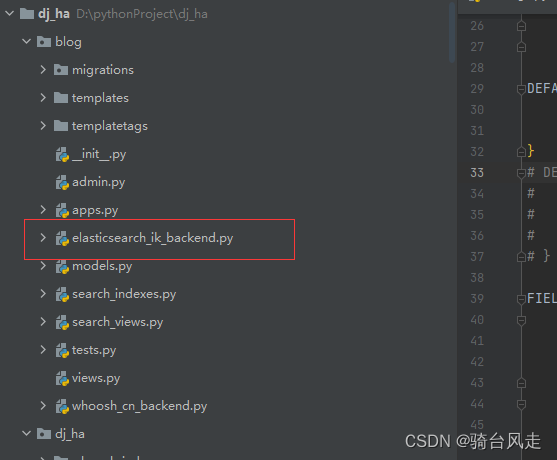
from haystack.backends.elasticsearch7_backend import Elasticsearch7SearchBackend, Elasticsearch7SearchEngine
"""
分析器主要有两种情况会被使用:
第一种是插入文档时,将text类型的字段做分词然后插入倒排索引,
第二种就是在查询时,先对要查询的text类型的输入做分词,再去倒排索引搜索
如果想要让 索引 和 查询 时使用不同的分词器,ElasticSearch也是能支持的,只需要在字段上加上search_analyzer参数
在索引时,只会去看字段有没有定义analyzer,有定义的话就用定义的,没定义就用ES预设的
在查询时,会先去看字段有没有定义search_analyzer,如果没有定义,就去看有没有analyzer,再没有定义,才会去使用ES预设的
"""
DEFAULT_FIELD_MAPPING = {
"type": "text",
"analyzer": "ik_max_word",
# "analyzer": "ik_smart",
"search_analyzer": "ik_smart"
}
class Elasticsearc7IkSearchBackend(Elasticsearch7SearchBackend):
def __init__(self, *args, **kwargs):
self.DEFAULT_SETTINGS['settings']['analysis']['analyzer']['ik_analyzer'] = {
"type": "custom",
"tokenizer": "ik_max_word",
# "tokenizer": "ik_smart",
}
super(Elasticsearc7IkSearchBackend, self).__init__(*args, **kwargs)
class Elasticsearch7IkSearchEngine(Elasticsearch7SearchEngine):
backend = Elasticsearc7IkSearchBackend
10.3 修改settings.py(切换成功)
# es 7.x配置
HAYSTACK_CONNECTIONS = {
'default': {
# 'ENGINE': 'haystack.backends.elasticsearch7_backend.Elasticsearch7SearchEngine',
'ENGINE': 'blog.elasticsearch_ik_backend.Elasticsearch7IkSearchEngine',
# 'URL': 'http://106.14.42.253:9200/',
'URL': 'http://106.14.42.253:9200/',
# elasticsearch建立的索引库的名称,一般使用项目名作为索引库
'INDEX_NAME': 'elastic_new',
},
}10.4 重建索引,同步数据
python manage.py rebuild_index
10.5 补充
10.5.1 未成功切换成ik
haystack 原先加载的是 …\venv\Lib\site-packages\haystack\backends 文件夹下的 elasticsearch7_backend.py 文件,打开即可看到 elasticsearch7 引擎的默认配置
若用上述方法建立出来的索引字段仍使用 snowball 分词器,则将原先elasticsearch7_backend.py 文件中的 DEFAULT_FIELD_MAPPING 也修改为 ik 分词器(或许是因为版本问题)
位置:D:\py_virtualenv\dj_ha\Lib\site-packages\haystack\backends\elasticsearch7_backend.py
修改内容:
DEFAULT_FIELD_MAPPING = {
"type": "text",
"analyzer": "ik_max_word",
"search_analyzer": "ik_smart",
}10.5.2 es6版本加入ik,重写引擎
from haystack.backends.elasticsearch_backend import ElasticsearchSearchBackend
from haystack.backends.elasticsearch_backend import ElasticsearchSearchEngine
class IKSearchBackend(ElasticsearchSearchBackend):
DEFAULT_ANALYZER = "ik_max_word" # 这里将 es 的 默认 analyzer 设置为 ik_max_word
def __init__(self, connection_alias, **connection_options):
super().__init__(connection_alias, **connection_options)
def build_schema(self, fields):
content_field_name, mapping = super(IKSearchBackend, self).build_schema(fields)
for field_name, field_class in fields.items():
field_mapping = mapping[field_class.index_fieldname]
if field_mapping["type"] == "string" and field_class.indexed:
if not hasattr(
field_class, "facet_for"
) and not field_class.field_type in ("ngram", "edge_ngram"):
field_mapping["analyzer"] = getattr(
field_class, "analyzer", self.DEFAULT_ANALYZER
)
mapping.update({field_class.index_fieldname: field_mapping})
return content_field_name, mapping
class IKSearchEngine(ElasticsearchSearchEngine):
backend = IKSearchBackend11.实时更新索原理:采用信号
配置
# 在django配置文件中,添加索引值,文章更新的时候,就会自动更新索引值
HAYSTACK_SIGNAL_PROCESSOR = 'haystack.signals.RealtimeSignalProcessor'RealtimeSignalProcessor源码如下:
class RealtimeSignalProcessor(BaseSignalProcessor):
"""
Allows for observing when saves/deletes fire & automatically updates the
search engine appropriately.
当 检索对象出现保存或者删除的时候更新索引值。
"""
def setup(self):
# Naive (listen to all model saves).
models.signals.post_save.connect(self.handle_save)
models.signals.post_delete.connect(self.handle_delete)
# Efficient would be going through all backends & collecting all models
# being used, then hooking up signals only for those.
def teardown(self):
# Naive (listen to all model saves).
models.signals.post_save.disconnect(self.handle_save)
models.signals.post_delete.disconnect(self.handle_delete)
# Efficient would be going through all backends & collecting all models
# being used, then disconnecting signals only for those.
本文借鉴
Django haystack实现全文搜索 – -零 – 博客园 (cnblogs.com)
(9条消息) django-haystack全文检索详细教程_AC_hell的博客-CSDN博客
(9条消息) Django全文检索Haystack模块_NQ31的博客-CSDN博客_django haystack
(9条消息) django+drf_haystack+elasticsearch_骑台风走的博客-CSDN博客
(5条消息) Haystack 使用 Elasticsearch 建立索引时 修改为中文分词器_SevenBerry的博客-CSDN博客_elasticsearch 修改字段分词器
(5条消息) Elasticsearch中analyzer和search_analyzer的区别_chuixue24的博客-CSDN博客
文章出处登录后可见!
